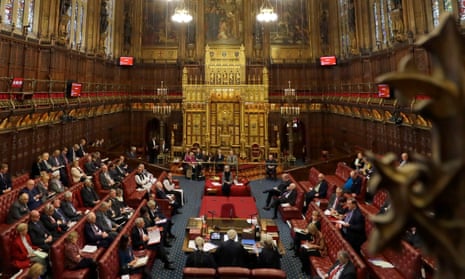Following the overdue evictions of Edward Colston and Robert Milligan, the list of statues whose associations with slavery make them candidates for retirement grows longer by the day.
Labour-run councils have agreed to consider “the appropriateness of local monuments on public land and property”. The mayor of London, Sadiq Khan, has also ordered a review: “Our capital’s diversity is our greatest strength, yet our statues, road names and public spaces reflect a bygone era.”
Would they mind extending their surveys to a group of living statues active – give or take – within the House of Lords? Specifically, its generous hereditary contingent, both the current, 92 members, and the names on an official register of interested peers (thereby eligible each time death creates a vacancy).
Not unlike the slavers’ statues as they merged into town landscapes, centuries of familiarity have offered this tarnished and fundamentally ugly institution, and its hereditary inmates, a measure of protection. “You’d never invent it now,” its ghastlier members like to say when reform is suggested, “but somehow it works.”
You’d never actually suggest that, to pick a name at random, a person such as Francis Baring, 6th Baron Northbrook, had any right to a seat in the legislature, since the public didn’t elect him, but there he is. Somehow, scores of old (usually), conservative (predominantly), white (always) men (exclusively), who are equally bereft of electoral legitimacy, enjoy their gentleman’s club to this day. But what if, amid the surge of concern about visible memorials to the British slave trade, it became more widely known that the current Francis Baring (an opponent of Lords reform) is descended from Francis Baring the anti-abolitionist and banker, who profited from slave-derived commodities? Baring Road in Lewisham, southeast London – nb Sadiq Khan – is also named after him. He dismissed as exaggerated the “physical sufferings of the Negro”.
How many sitting or registered hereditaries from slave-trade connected families would it take for this already anachronistic section of the legislature to be recognised, no less than offensive street names and statues, as terminally indefensible?
Thanks to the trouble taken by hereditary peers to declare their ancestry, since this represents their entire claim to special status, and to the brilliant University College London database of slave ownership, some names quickly raise questions.
Pick, for instance, out of a host of candidates, the Conservative peer and celebrated moat-dredger Douglas Hogg, Viscount Hailsham. He descends from Charles McGarel, a merchant compensated £129,464 (which has been estimated at over £100m today) for 2,489 slaves. Another Tory peer, Lord Carrington, in the Lords since 2018, leads us to an earlier Baron Carrington who received £4,908 in compensation for the loss of 268 slaves. Consider also the 14th Lord Fairfax of Cameron, a Conservative peer, whose slave-trading ancestor, the 6th Lord Fairfax of Cameron, owner of vast plantations in Virginia, reportedly enjoyed what he called “bedding down with a negro wench”. Or, as we would now think of it, rape.
Seaford of Sussex, on the House of Lords register, is descended from slave owner George Ellis, compensated for more than 1,000 slaves. His co-aspirant, the 9th Earl Temple of Stowe, shares at least one name with Richard Temple-Nugent-Brydges-Chandos-Grenville, an opponent of abolition: “The moment this bill was passed, the death warrant of every white man in the West Indies would be sealed.”
Viscount Combermere, a potential candidate, recalls the first Viscount Combermere, compensated with a fortune for slaves in Nevis and St Kitts. His statue is – still – in Chester. The anti-abolition ancestors of Lord Onslow (on the register), built Clandon Park with the proceeds, celebrated in its decorations, of slavery. Having accidentally let Clandon burn down, its current owner, the National Trust, intends a tasteful refurb.
Slave fortunes, legacies and compensation that furthered historic prominence are still, effectively, being used to extract unearned status, stipends and political influence. If Colston’s statue deserved its disgrace, why, to pick yet another example, is Simon Douglas-Pennant, 7th Baron Penrhyn, entitled to ornament the upper house? Any of the baron’s personal achievements, and no doubt there are many, are irrelevant to that ambition. Rather it can only advertise to anyone interested, the scale of his debt to earlier Douglas-Pennants, whose exploitation of 1,000 slaves funded, among other things, the Penrhyn estate in north Wales. After abolition, the family won the then vast sum of £14,683 17s 2d in compensation.
The National Trust, proprietors of the family’s hideous 19th-century new-build, offers some glimpses of his forebears. Richard Pennant, a dedicated anti-abolitionist, instructed staff to take care of his assets: “I do not wish the cattle nor the negroes to be overworked.”
On the bright side, the National Trust says of Penrhyn Castle: “You can’t help but be taken aback by the vast luxurious rooms, Gothic stairways and fine art on display. Hear tales of star-crossed lovers, sugar and slate fortunes and delve ‘below stairs’ into the Victorian kitchens.” If the National Trust now opens up, occasionally, about slave connections in its properties, it has yet to lose the habit of romanticising local servitude. It will be another valuable consequence of the current mass learning and re-evaluating, if the owners, charitable and private, of historic houses, abandon coy allusions to plantations, sugar trade and domestic routines, in exchange for honesty about the abject exploitation upon which they depended.
As for the hereditaries, it’s possible similar euphemisms left some of them not aware, or only dimly so, of the slave trade’s role in their family fortunes. Lord Gage of Firle Place, who has joined the register of genetically qualified, has said he was shocked to find, following UCL’s revelations, that his ancestor John Gage received £1,759 8s 11d compensation for 108 slaves. But since he hasn’t withdrawn his name, perhaps not quite as shocked as you’d expect.

